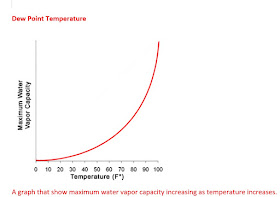For
this post, I will discuss a little on dew point and relative humidity.
The amount
of water vapor in the air is called humidity.
There are two
kinds of humidity, Absolute humidity is the measure of water vapor
(moisture) in the air, regardless of temperature. Relative humidity also
measures water vapor but relative to the temperature of the air. For
the purpose of this post I will only briefly discuss relative humidity due to its
relationship to dew point.
Relative Humidity:
Relative humidity is a percentage of the amount of water vapor in the air of the total amount that could be held at its current temperature. The warmer the air the more water vapor it can hold.
Warm air can
hold far more moisture than cold air meaning that the relative humidity of cold
air would be far higher than warm air if their absolute humidity levels were
equal. If the amount of water vapor in the air stays the same, but the
temperature goes down, the relative humidity will increase. This is because the
colder air cannot hold as much water vapor. If the temperature gets cold
enough, the air gets to the point that it is holding the most water vapor it
can hold. The relative humidity for this temperature would be 100 percent. This
is also known as the dew point temperature.
Dew Point:
All Y’all
hear the term dew point all the time on your local weather forecast during the
summer. But what the heck is dew point really? And why should you care?
Dew point is
the temperature to which a parcel of air must be cooled in order to reach
saturation by the water vapor already present in the air. A parcel is like a helium
balloon as it rises up into the air. The
higher the dew point, the more moisture there is in the air.
To put all
of this in simpler terms, is that the dew point is the temperature at which the
moisture in the air becomes liquid water. It is a complicated calculation to
determine the dew point, but fortunately y’all don’t need to do the math. Here’s
a chart that will show you the approximate dew point.
Dew point
temperature is a marvelous indicator of how comfortable you'll feel outside. The
higher the dew point rises, the greater the amount of moisture in the air, the
higher the dew point, the harder it is for the sweat on your skin to evaporate,
and the hotter and muggier the air will feel.
Going back
to relative humidity, many times it can be misleading. For example, a
temperature of 30 and a dew point of 30 will give you a relative humidity of
100%, but a temperature of 80 and a dew point of 60 produces a relative
humidity of 50%. It would feel much more "humid" on the 80-degree day
with 50% relative humidity than on the 30-degree day with a 100% relative
humidity. This is because of the higher dew point.
When the air
temperature gets down to the dew point, some of the water vapor turns back to
liquid water (condensation). That fog you see on the mirror after you take a
shower; is the result of dew, which is just liquid water that has condensed out
of the air.
Human body
temperature is dependent on the air as it absorbs and removes moisture from our
skin to cool us down. If the relative humidity is high, the amount of
water evaporating from our skin is limited so we feel warm and smothered.
A dew point
temperature less than 50 degrees is considered dry, 50-68 degrees is
comfortable, 69-76 degrees is uncomfortable, while greater than 77 degrees is
considered extremely uncomfortable.
The basic
meaning of other heat related terms.





No comments:
Post a Comment
Thank you for taking the time to comment, I will answer as soon as I can.